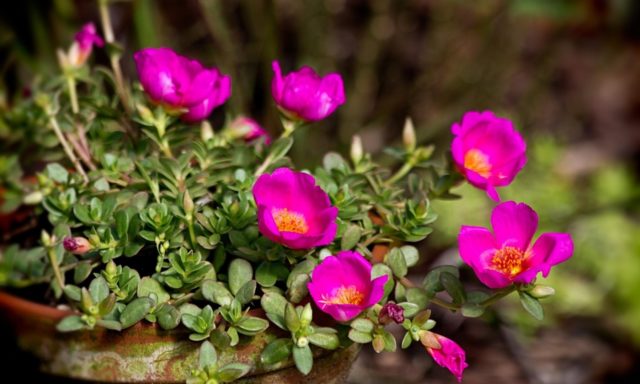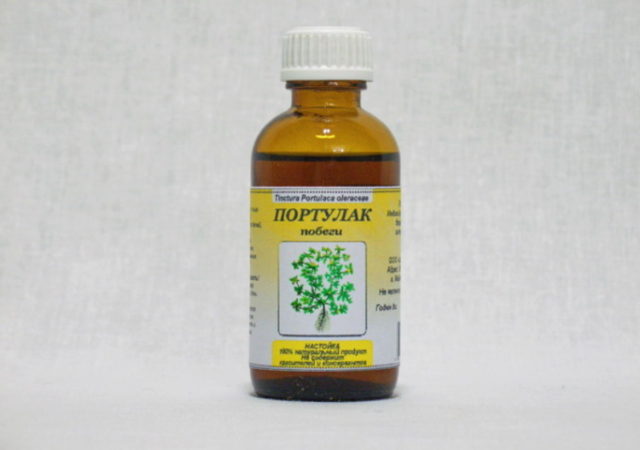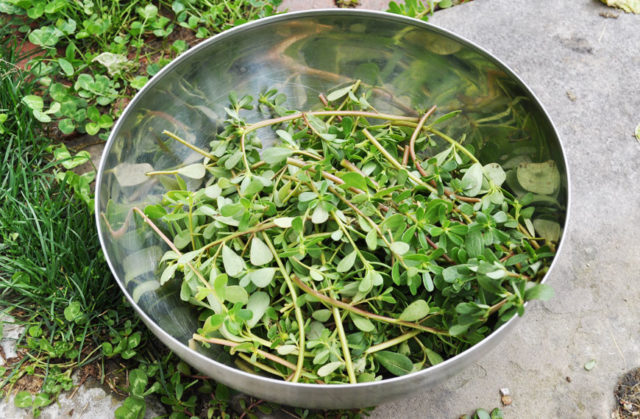Content
The medicinal properties and contraindications of garden purslane are the subject of controversy among supporters of alternative medicine. The plant is often used for diseases of the kidneys, respiratory tract and digestive system. In some cases, it is used in the early stages of diabetes. The multifunctionality of the medicinal herb is due to its rich composition.
What does purslane look like and where does it grow?
Purslane is an annual herb of the Purslane family. His homeland is considered the tropics of the Eastern Hemisphere. Today the plant is found everywhere. On the territory of Russia, purslane grows in the Far East and the Caucasus. In most countries, it is considered a weed. He prefers black soil without any fertilizers and a warm climate.
Purslane, the photo of which is presented below, was first mentioned as a remedy in India and Iran. Amulets were made from it, designed to protect against diseases and dark forces. The plant has a recumbent smooth red stem. Its length can reach 30-40 cm. The upper leaves of the purslane are opposite, and the lower ones are arranged spirally. They are spatulate or wedge-shaped. Yellow flowers are arranged in groups of 2-3 pieces. The fruits are a capsule with a transverse crack in the middle. The flowering period is June-August. Flowers are white, yellow and pink. Purslane fruits appear in September.

Chemical composition of purslane
Garden weed contains a lot of nutrients. The main value lies in the content of the fatty acid complex. They are one of the main sources of energy. Purslane contains the following components:
- alkaloids;
- saponins;
- organic acids;
- choline;
- proteins;
- tar and slime;
- macro- and microelements (magnesium, zinc, potassium, iron, nickel, calcium, copper, sodium);
- norepinephrine;
- vitamins C, A and PP;
- glycosides.
Due to the content of norepinephrine, the plant is prohibited for use by persons with nervous disorders. It replenishes energy, but increases irritability. Thanks to alkaloids, purslane stops bleeding and has an analgesic effect. Organic acids are involved in digestion processes. The diuretic effect is achieved due to the content of saponins. In addition, they prevent the formation of atherosclerotic plaques in the vascular cavity. The choline present in the plant stimulates the digestive system.
Why is purslane useful?
The chemical composition of the plant does not allow doubting its benefits. That is why purslane is in demand in alternative medicine. It is highly effective against inflammatory and infectious diseases.Useful properties of garden purslane are as follows:
- diuretic effect;
- lowering the level of bad cholesterol;
- stabilization of the emotional state;
- cleansing the blood and stopping bleeding;
- antipyretic effect;
- lowering blood pressure;
- antiparasitic effect;
- normalization of the cardiovascular system;
- protection against intestinal infections;
- preservation of youth;
- anti-inflammatory effect.
Purslane has a fairly wide range of applications. It helps to cope with diseases accompanied by intoxication and inflammatory processes. It is often used to treat skin ailments and various liver damage. The plant's antioxidant properties allow it to be used to eliminate parasitic diseases.
For women, the value of the plant lies in maintaining youth and reproductive health. It can be used during pregnancy planning. The rich content of folic acid prepares the body for gestation, and ascorbic acid activates its defense mechanisms.
How to use purslane
The purslane plant can be applied internally and externally. The most common forms of the remedy are decoctions and infusions. They are used for washing wounds, making compresses and rinsing the mouth. Internal reception is practiced for diseases of the digestion, kidneys and hematopoiesis. For the preparation of medicinal products, not only leaves are used, but also plant seeds. They are especially effective against parasitic diseases.

Purslane for insect bites
Healing herb can be used to eliminate discomfort after insect bites. For this purpose, a blender is used to make healing juice. It is applied to the inflamed area for 3 minutes, and then washed off with warm water. The relief comes almost instantly.
From peptic ulcer
For gastric ulcer, purslane decoction is used. Reception is carried out in 1 tbsp. l. before eating. To prepare the broth, the following components are required:
- 200 ml of water;
- 1 tbsp. l. crushed leaves.
Recipe:
- Raw materials are poured with water and boiled for 15-20 minutes.
- After removing from heat, the broth is infused for half an hour.
- Filter the drink before use. You need to take it cold.
For skin diseases
When using purslane, an excellent therapeutic effect is observed in relation to skin diseases. It not only eliminates uncomfortable sensations, but also relieves inflammation. The desired effect is achieved due to unsaturated fatty acids in the plant. Purslane broth is applied to problem areas pointwise.
With diabetes
Purslane weed can be used to prevent diabetes and treat its early stages. It helps to equalize blood glucose levels and improve well-being. For infusion, the following components are required:
- 400 ml hot water;
- 2 tbsp. l. dried herbs.
Cooking process:
- Purslane leaves are poured with boiling water and insisted all night.
- In the morning, filter the drink.
- Reception is carried out in 3 tbsp. l. 3 times a day. The broth should be drunk after meals.

Purslane during pregnancy
When consumed during pregnancy, the plant has a positive effect on health. Vitamins in its composition are necessary for a child for full development. Fatty acids prevent various abnormalities.Due to the diuretic effect, the remedy helps to get rid of edema, which is especially important in the last stages of pregnancy. In the beginning, purslane helps to cope with toxicosis. However, the plant can only be used with a doctor's permission and in limited dosages. This is due to the likelihood of impact on hormonal levels, which may result in abortion.
Purslane while breastfeeding
Purslane herb can also be used while breastfeeding. It helps the female body to recover faster after childbirth. The substances in its composition improve the condition of hair, nails and skin. When they enter breast milk, they increase its nutritional value. If you need to use purslane, you should observe the baby's reaction. In some cases, herbal medicine provokes the development of allergies in children.
For constipation
Because of its mild laxative effect, purslane is often used to treat constipation. Herbal infusion is recommended to take 2-3 tbsp. l. after every meal. With prolonged constipation, fresh leaves of the plant are shown for use. They can be added to vegetable salads instead of herbs. The course of treatment depends on the severity of the problem.
How to take purslane for weight loss
When used correctly, purslane helps in weight loss. It starts metabolic processes, thereby accelerating fat burning. Leaves are often eaten. They are low in calories, but also high in nutritional value. Due to their fiber content, they help cleanse the intestines from toxins and speed up the process of digestion. It is especially useful to use purslane with meat dishes as a dinner. Dried, it can be useful as a seasoning.

The use of purslane in cosmetology
Purslane is also widely used in cosmetology. The positive effect on skin condition is due to the rich content of vitamin A. It reduces the number of wrinkles and gives the skin elasticity. Fatty acids prevent excessive dryness and flaking. Masks made from crushed leaves of the plant do an excellent job with age spots on the face. They are often practiced to speed up regenerative processes.
Vegetable purslane can also be used to treat thermal damage. It soothes irritated skin and facilitates the healing process. The likelihood of scarring is significantly reduced. The anti-inflammatory properties of the plant are relevant for skin diseases and single rashes. To eliminate them, purslane broth is used as a cleansing lotion.
The medicinal plant has a positive effect on the appearance of the hair. A cosmetic herbal infusion is recommended to be rubbed into the scalp to get rid of dandruff and relieve itching. If used as a rinse, you can make your hair softer and more manageable. Regular treatment contributes to shine and dryness.
Contraindications
Despite the abundance of nutrients in the plant, the doctors' opinions about it are quite contradictory. It is believed that purslane is able to carry not only benefits, but also harm to health. That is why the plant has a number of contraindications. These include the following:
- hypertension;
- individual intolerance;
- increased nervous tension.
It should be remembered that when consumed in excessive amounts, the plant can speed up heart rate and increase blood pressure levels. In rare cases, it provokes an allergic reaction, manifested in the form of a skin rash.
Collection and procurement
For use for medicinal purposes, it is customary to harvest purslane for future use. Harvesting is carried out only if the length of the shoots reaches 20 cm. This usually happens about a month after the appearance of the first shoots. During the entire vegetative period, it is permissible to cut the leaves several times. Harvesting purslane is prohibited after the seeds have ripened.
The collected raw materials must be dried. It is preliminarily cleaned of the earth. And then laid out on a clean, flat surface. Newspapers or cloth can be used as a backing. Drying is carried out in a ventilated area, excluding direct sunlight.
When dried, the plant should be kept away from moisture and sun. It is advisable to place it in a glass or plastic container with a lid. It is not recommended to store the workpiece in a basement or other room with high humidity. If the conditions are met, the shelf life of dried purslane is 2 years.
Conclusion
The medicinal properties and contraindications of garden purslane are most often discussed in a positive way. The plant is famous for its rich composition and broad spectrum of activity. Saturating the body with useful substances, it significantly strengthens the defenses and effectively copes with existing diseases.

